Feb 22, 2022
The Ureshino Story: The tea farmer taking a new approach to tradition
The city of Ureshino in Saga Prefecture, southwestern Japan, is home to the proud cultures of Ureshino tea, onsen (hot springs) and porcelain. This is the fourth and final article in our series showcasing the forward-thinking, local creatives from each of these respective industries who have joined forces to help safeguard the future of Ureshino's cultures.
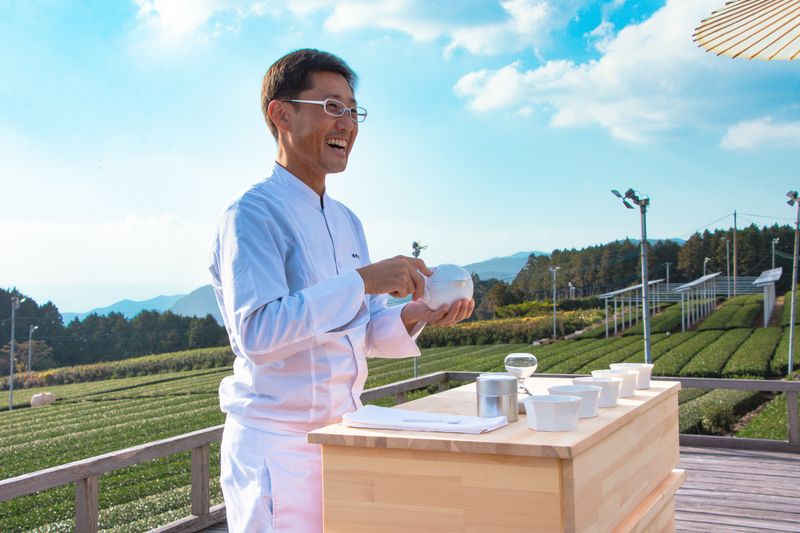
“The highest level of the tea world is the tea ceremony. The tea ceremony established by Sen no Rikyu is said to be the pinnacle of this,” Ureshino tea farmer and tea master Shuichi Kitano explained.
“With the tea ceremonies we conduct as Chadoki we’re using sencha. We serve tea using the senchado method, although there are essentially no sencha schools of thought, so rather than following any kind of tradition you can do things based on lifestyle.”
“It’s kind of free. So, we thought it would be good to turn things on their head.”
Whatever image of the Japanese tea ceremony that one holds, it's likely that the experience of a ceremony hosted by Kitano at the Chatou (Tea Tower) will turn it on its head, if not leave your own head spinning.
The Tea Tower is actually a platform rising a few meters above the tea fields of a plantation in the mountains south of central Ureshino City, Saga Prefecture. While the platform itself is not so high, the location veritably soars.
All around, verdant mountain peaks reach for the sky. Kitano lays down zabuton cushions that have us facing southwest toward the ceremonial counter where he prepares and pours tea, and beyond him to the waters of Omura Bay in the distance.
One wonders how the 16th-century tea master Sen no Rikyu might have felt serving his tea from way up here.
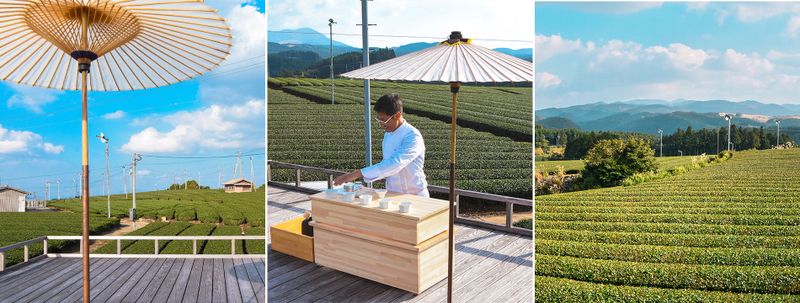
(Chatou (Tea Tower), Ureshino, Saga Prefecture.)
Although Ureshino’s over 500-year history of tea cultivation predates Rikyu’s life by around a century, the latter’s influence on the way of tea in Japan is considered profound. The prominent schools of tea ceremony, Omotesenke, Urasenke, and Mushakojisenke, can all be traced back to Rikyu’s teachings.
Maybe the great master would have appreciated the great outdoor setting. Rikyu is, after all, thought to have sought to combine aesthetics with an appreciation of nature in his ceremonial accouterments. And while the wide open space may be at odds with the intimate confines of a teahouse constructed in Rikyu’s image, Kitano’s engaging energy ensures a warm connection between master and guest.
Back on his own farm just outside central Ureshino, in the warm surrounds of a tea space of his own making, Kitano spoke more about his approach to presenting tea, and that of the group of which he is a member, Ureshino Chadoki.
“When it comes to Chadoki’s ceremonies, the thinking is that it’s OK to bring in new ideas,” he said.
It seems that a lot of what is new in Ureshino tea has been coming from the creative association Ureshino Chadoki which brings together leading figures from each of Ureshino’s cherished traditions and the industries that have grown up around them - tea, onsen, and porcelain.
It’s rare for a town in Japan the size of Ureshino (with a population of around 25,000) to be able to boast of three such traditions dating back centuries - over one thousand years in the case of Ureshino’s onsen. The people behind Ureshino Chadoki have charged themselves with ensuring that these traditions are not so rare that they become confined to dusty heritage. That there be something worth passing on to future generations.
“Of course, it’s not about compromising the quality. Rather, it’s about raising the value,” Kitano said of Ureshino Chadoki's efforts to take the traditions in a new direction.
The group has sought to find this new value in Ureshino tea - Ureshino-cha - in particular, through sharing and employing their respective resources and expertise toward the common cause. Ureshino’s onsen ryokan operators bring the space and hospitality know-how, Hizen Yoshida-yaki potters the craftsmanship and tea ware. Farmers like Kitano bring the tea. And serve it.
“When it came to tea we didn't have a lot of people around us telling us what to do, so we just asked ourselves, ‘What should we do? How about doing it like this?’ We started from zero.
We tried a few patterns and found things that worked and things that didn't,” Kitano explained.
Ureshino Chadoki events and initiatives often create a medium in which tea farmers like Kitano assume the role of “tea master,” brewing and then serving their own teas directly to customers.
According to Kitano, the group had identified such a service as having not been offered before - one in which the customer could have their tea brewed, poured and explained right in front of them by the very farmer who produced it.
“At the start, people would question what we were doing,” Kitano said of early outside reaction to the group’s approach.
Prior to joining the group himself, the farmer in Kitano had his own reservations.
“When I first saw what the Chadoki members were doing, the impact on me was such that I wondered if it would be possible for a tea farmer to do such a thing. It was completely different from anything I had ever done before,” he said.
Including, it seems, wearing the brilliant white uniform of the Ureshino Chadoki tea master, which can cut quite the contrast when set against the greens of the tea plantations and mountainsides.
“Everyone was against it,” said Kitano, letting out a laugh about early opinion of the uniform.
“We can’t wear this!”
Kitano and other members of the group have come to understand, though, that the tea master-style presentation is an important factor in adding value to the Ureshino tea experience. As is the setting.
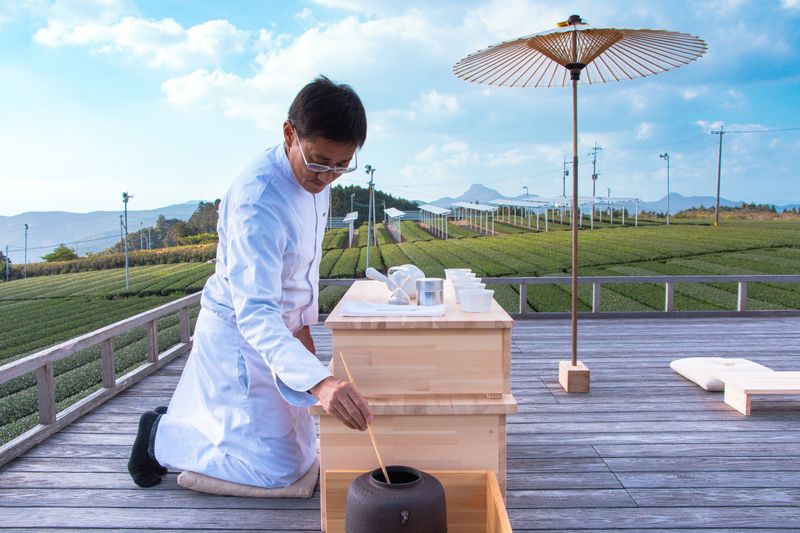
(Tea farmer Shoichi Kitano in uniform as he prepares for a tea ceremony at the Chatou (Tea Tower.))
Today, the visitor to Ureshino can take their tea, served by a farmer and master like Kitano, at a number of tea spaces dotted around the stunning landscape. These include the spectacular heights of the Tea Tower, or under a pergola surrounded by forest at the Mori no Chashitsu. For a more urban setting, people can also enjoy their Ureshino tea experience under the mood lighting of a luxury hotel bar counter.
The first Ureshino Chadoki event was held in the summer of 2016, followed the next year by the first of the tea spaces. In those early days most of the visitors who came to enjoy the Ureshino tea experience were people practicing or conducting ceremonies themselves, along with other related teachers and instructors, according to Kitano.
Nearly five years later and more eyes are on Ureshino and the region’s tea experiences.
“People who hadn’t noticed what was happening here are now looking this way,” he said.
Kitano talked about a customer from Tokyo who last summer came to Ureshino for a tea experience after having read a newspaper article about Ureshino Chadoki the previous year.
“The customer said that they had wanted to come and drink tea here in Ureshino. They held onto this feeling despite the coronavirus situation making it difficult for them to come. They even made a reservation which they eventually had to cancel because of the state of emergency. When the situation got better they were finally able to come to Ureshino,” he explained.
“The idea of a journey starting out as a desire for a cup of tea, and then realizing that desire, really left an impression on me.”
Kitano’s own journey toward a life in tea started in Ureshino, where he was born and raised, and where he eventually became the third generation farmer at his family’s Kitano Chaen tea plantation.
During his youth, however, Kitano had eyes for a different future. While attending a high school in Saga Prefecture that had a strong reputation in the long-distance multi-stage running races known in Japan as “ekiden,” Kitano saw himself as more of an athlete than a farmer.
“I aimed to become an ekiden athlete and lived life thinking that I would be able to compete in the Hakone Ekiden in the future,” he explained, referencing the famous annual road race between central Tokyo and the onsen town near the foot of Mt. Fuji.
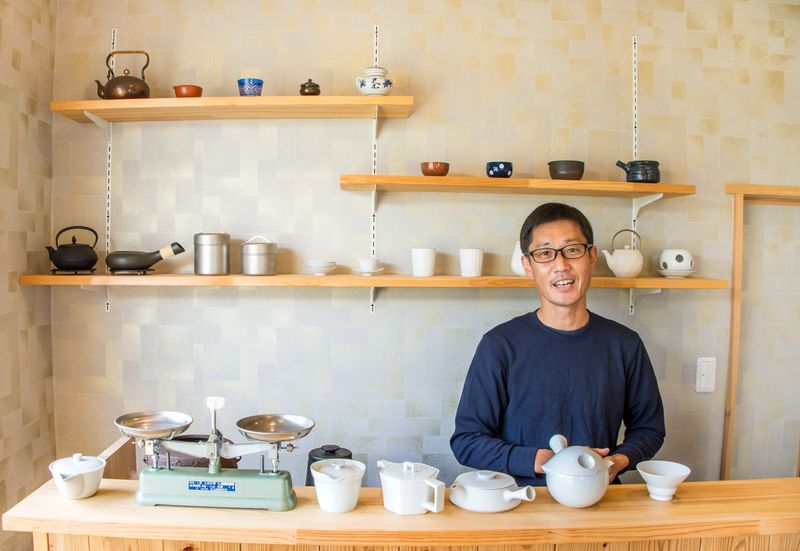
(Shoichi Kitano in the tea space at his farm Kitano Chaen, Ureshino, Saga Prefecture.)
The running shoes would ultimately be retired before that dream could be made reality. Instead, Kitano went into tea, leaving Ureshino to study in Shizuoka Prefecture before returning home to go into farming at Kitano Chaen at the age of 21.
“Ever since I could remember, my father, mother, the elderly people around me, they had been saying to me, ‘In the future you're going to be the one who works in this field.’ Even if I wanted to go to university or do something else in the meantime, I had already decided that I would come back and grow tea, or rather, I just knew that I would.”
In print Kitano’s remarks might read as if filled with a sense of tired resignation about an inevitable future. In person though, they come across as anything but. In fact, Kitano appears to have retained the energy of his running days and put it into his approach to tea.
Years before Ureshino Chadoki was even an idea Kitano grew up under the influence of his father, a farmer who also sought to take a different approach in producing tea.
“My father had been growing organic and pesticide-free tea since the beginning of the Heisei era (from 1989), so I kind of knew that we were different from ordinary tea farmers because of that,” he explained.
Looking back on his return to his hometown and the early days of his work in tea, Kitano remembers the time fondly.
“It was a time when I started thinking about what I could do to make my life as a tea farmer more enjoyable, rather than feeling that I didn't want to do it,” he said.
Over two decades on and the energy of the runner continues to pour out of Kitano as he talks with enthusiasm about the future of his tea and of Ureshino. Indeed, the creative and open minded approach of Ureshino Chadoki and other like minded souls appears to be a good match for Kitano who seems to value the collaborative spirit that they bring.
“Even if I were to show (potential partners) my business card and my tea, and explain that I have been producing pesticide-free products in Ureshino for 30 years, they would probably say, ‘So what?’ However, together with Chadoki we have been able to make the best use of the great products of the region.”
A recent collaborator with some of the group’s members, including the operators of the Ureshino ryokan Wataya Besso, was French pâtissier Pierre Hermé. Tea from Kitano’s own Kitano Chaen was used to flavor a set of macarons that featured in a Pierre Hermé Paris collaborative set showcasing traditional crafts and tea ware.
“A representative of Pierre Hermé came to Ureshino and we went to the Tea Tower together. They had the tea space experience and became interested in what we were doing. Things developed from there,” Kitano explained.
“This kind of flow might not have been possible had Wataya Besso tried to do something on their own, but I think the inclusion of tea farmers and potters helped to make things more complete.”
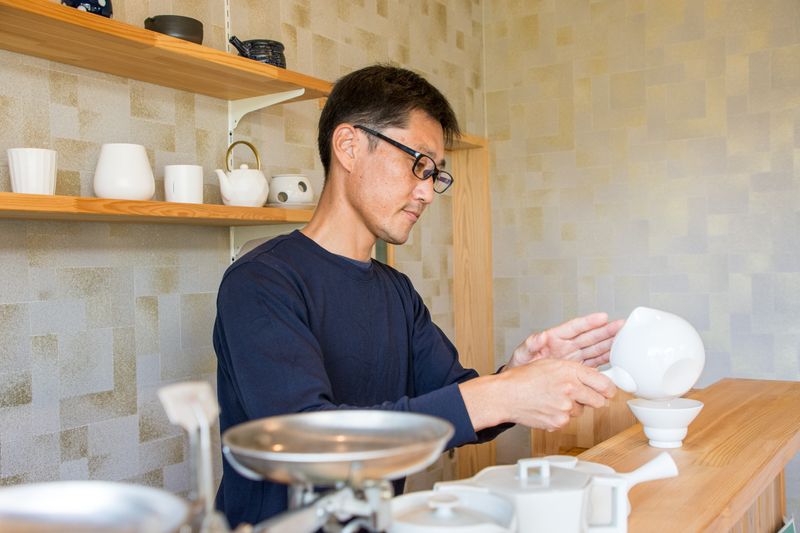
(Shoichi Kitano, Kitano Chaen.)
Whoever the collaborator, whatever the new approach, wherever the setting, Kitano remains focused on the outcome when it comes to the experience of Ureshino tea.
“I believe the most important thing for the people who have been looking forward to drinking tea here, is that they come away from their experience knowing the tea to be delicious and to have felt happy during the time they were drinking it.”
This article was supported by Ureshino Chadoki.



0 Comments